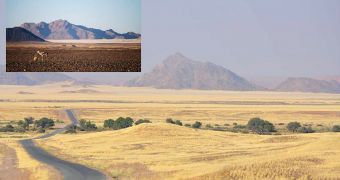A group of researchers in the United States say that the standard weather patterns in the African nation of Namibia are being thrown off-balance by an unknown factor. According to the two, weather events that should not be taking place in that climate happen, much to their surprise.
The team was led by Kyle Nichols, a geoscientist at the Skidmore College in Saratoga Springs, New York, and Paul Bierman, who is a geoscientist at the University of Vermont in Burlington. The two just returned from a research trip in western Namibia.
Bierman explains that this particular region usually shows a consistent landscape of dusty stream beds and lakes made entirely out of dry mud. The area is extremely dusty, and changes in the environment occur perhaps once every decade.
However, this year was extremely unusual. Streams and rivers like Swakop, Omaruru and Kuiseb flowed all the way to the sea, while grasses grew where only sand existed just a year before. Some of the rivers had so much water that they made their way into the open sea.
For weeks, these flowing waters took water out of the desert and into the sea, which is something that is highly unusual. When these rivers normally become activated, they tend to only flow for a few days.
“There was so much water, that people went swimming, they went tubing, and the desert turned green around rivers carrying so much sediment they were chocolate-brown,” Bierman explains, saying that heavy, prolonged rains were the main cause of this shift.
Throughout Namibian weather records, investigators could not identify a time when similar rains had fallen from the sky over the dusty African nation. “There's nothing like this widespread, heavy rain in the historic record,” the team member explains.
Using a rapid response grant provided by the US National Science Foundation (NSF), the team flew back to Namibia after the recent rains, and visited sites that they had previously sampled back in 1997, 2001 and 2010. This gave them the continuity they needed for their research.
“The research focuses on the use of isotopes of the chemical elements beryllium, cesium and lead to measure erosion rates and determine sediment sources,” explains NSF Division of Earth Sciences program manager Paul Cutler.
“Techniques using these isotopes have become increasingly popular, as ways of finding out the sources and ages of sediments and other rock deposits,” he adds. The DES provided the rapid response grant.
“This could all be coincidence,” Bierman says, referring to Hurrican Irene, “but it's hard not to think that something's up with the weather. A warming Earth equals a more intense hydrologic cycle, with repercussions for erosion rates, sediment redistribution and landscape evolution,” he concludes.

 14 DAY TRIAL //
14 DAY TRIAL //